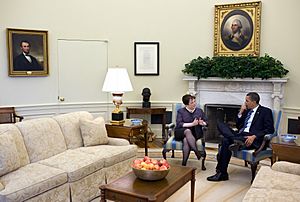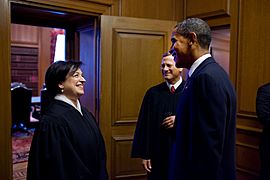Elena Kagan facts for kids
Quick facts for kids
Elena Kagan
|
|
|---|---|
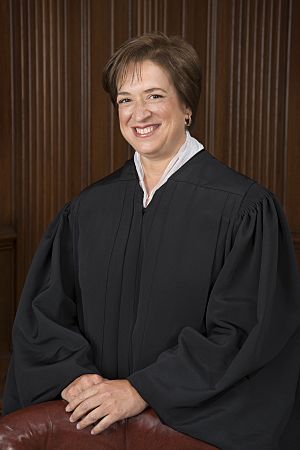
Official portrait, 2013
|
|
| Associate Justice of the Supreme Court of the United States | |
| Assumed office August 7, 2010 |
|
| Nominated by | Barack Obama |
| Preceded by | John Paul Stevens |
| 45th Solicitor General of the United States | |
| In office March 19, 2009 – May 17, 2010 |
|
| President | Barack Obama |
| Deputy | Neal Katyal |
| Preceded by | Edwin Kneedler (acting) |
| Succeeded by | Neal Katyal (acting) |
| 11th Dean of Harvard Law School | |
| In office July 1, 2003 – March 19, 2009 |
|
| Preceded by | Robert Clark |
| Succeeded by | Martha Minow |
| Deputy Director of the Domestic Policy Council | |
| In office 1997–2000 |
|
| President | Bill Clinton |
| Preceded by | Jeremy Ben-Ami |
| Succeeded by | Eric Liu |
| Personal details | |
| Born | April 28, 1960 New York City, U.S. |
| Political party | Democratic |
| Education | |
| Signature | |
Elena Kagan (KAY-guhn; born April 28, 1960) is an American lawyer. She is an associate justice on the Supreme Court of the United States. President Barack Obama appointed her in 2010. She is the fourth woman to serve on the Court.
Kagan grew up in New York City. She studied at Princeton University, Worcester College, Oxford, and Harvard Law School. She then worked for a federal judge and for Supreme Court Justice Thurgood Marshall. Later, she became a professor at the University of Chicago Law School. She also worked as a policy adviser for President Bill Clinton.
Before joining the Supreme Court, Kagan was the first female dean of Harvard Law School. In 2009, she became the first female Solicitor General of the United States. This role means she was the U.S. government's top lawyer in cases before the Supreme Court. In 2010, the United States Senate approved her nomination to the Supreme Court. She is the most recent justice appointed without any prior experience as a judge.
Contents
Early Life and Education
Elena Kagan was born on April 28, 1960, in Manhattan, New York City. She was the second of three children. Her father, Robert Kagan, was a lawyer. Her mother, Gloria Kagan, was a teacher. Both her parents were children of Russian Jewish immigrants.
Kagan was known for being independent and strong-willed as a child. She enjoyed literature and reread Jane Austen's Pride and Prejudice every year. In her high school yearbook, she was pictured in a judge's robe. Next to her photo was a quote from Justice Felix Frankfurter: "Government is itself an art, one of the subtlest of arts."
Schooling and University
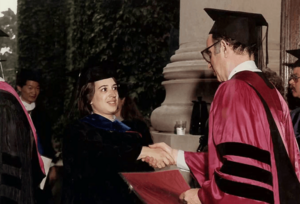
Kagan attended Hunter College High School, where her mother taught. This school was known for being one of the best for high school girls in New York City. Kagan was a top student. She was elected president of the student government.
She then went to Princeton University and graduated in 1981. She earned a Bachelor of Arts degree in history with high honors. She loved American history and doing research. Her senior paper was about socialism in New York City.
As a college student, Kagan also led the editorial board of The Daily Princetonian, the university newspaper. She and other students wrote a "Declaration for a Democratic University." It called for changes in how the university was run.
In 1980, Kagan received a special scholarship from Princeton. This allowed her to study at Worcester College, Oxford in England. She earned a Master of Philosophy degree in politics there in 1983.
Harvard Law School
In 1983, at age 23, Kagan started at Harvard Law School. She worked hard and earned high grades after her first semester. She became a supervisory editor for the Harvard Law Review. This is a very important student-run legal journal.
She graduated in 1986 with a Juris Doctor degree, also with high honors. Her friend Jeffrey Toobin said Kagan "stood out from the start as one with a formidable mind." He also noted that she was good with people. She could easily work with different groups at the law school.
Career Path
Early Legal Work
After law school, Kagan worked as a law clerk. From 1986 to 1987, she worked for Judge Abner J. Mikva. He was a judge on the U.S. Court of Appeals for the District of Columbia Circuit. He called her "the pick of the litter," meaning she was one of the best.
From 1987 to 1988, Kagan clerked for Justice Thurgood Marshall on the U.S. Supreme Court. Marshall was a very important justice. He nicknamed Kagan "Shorty" because she was 5 feet 3 inches tall.
From 1989 to 1991, Kagan worked at a private law firm in Washington, D.C.. She handled cases involving the First Amendment, which protects freedom of speech.
In 1991, Kagan became a professor at the University of Chicago Law School. There, she met Barack Obama, who was a guest lecturer. She wrote articles about how the government regulates speech. These articles became very important in legal studies.
In 1993, Senator Joe Biden hired Kagan as a special counsel for the Senate Judiciary Committee. She helped with the Supreme Court confirmation hearings for Ruth Bader Ginsburg. Kagan became a tenured professor in 1995. This means she had a permanent teaching position.
Working in the White House
Kagan worked for President Bill Clinton in the White House from 1995 to 1999. She was an Associate White House Counsel. She also worked as a policy adviser. She helped with topics like the government budget and social welfare.
In 1999, President Clinton nominated Kagan to be a judge on the U.S. Court of Appeals. However, the Senate did not hold a hearing for her nomination. So, she did not become a judge at that time.
Leading Harvard Law School
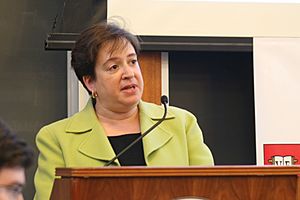

After her time in the White House, Kagan returned to teaching. In 2001, she became a full professor at Harvard Law School. In 2003, she was named the dean of the Law School. She was the first woman to hold this position.
As dean, Kagan focused on making students happier. She helped build new facilities and changed the first-year courses. She was known for her leadership style, which brought people together. She hired many new professors, including some conservative scholars. This helped balance the faculty, which was usually more liberal.
During her time as dean, Kagan supported a policy that limited military recruiters on campus. This was because she felt the military's "Don't Ask, Don't Tell" policy discriminated against gay and lesbian people. She believed it was a "moral injustice."
In 2007, Kagan was considered for the president of Harvard University. However, the position went to someone else.
Serving as Solicitor General
On January 5, 2009, President-elect Barack Obama announced he would nominate Kagan to be Solicitor General. This is the government's top lawyer who argues cases before the Supreme Court. At the time, Kagan had never argued a case in any court.
During her confirmation hearings, senators asked if she would defend laws she personally disagreed with. Kagan said she would defend any law if there was a good legal reason to do so. The Senate confirmed her on March 19, 2009. She was the first woman to hold this important position.
As Solicitor General, Kagan argued six cases before the Supreme Court. She was known for her "confident" and "conversational" style. She helped win four of these cases.
Supreme Court Justice
Nomination and Confirmation
Before Obama became president, people thought Kagan might be a Supreme Court nominee. In 2009, Justice David Souter retired. Obama chose Sonia Sotomayor for that vacancy.
Then, in April 2010, Justice John Paul Stevens announced his retirement. This led to new talk about who Obama would choose. Many believed Kagan would be the nominee. Her friend Jeffrey Toobin called her "a moderate Democrat, a consensus builder."
On May 10, 2010, President Obama nominated Elena Kagan to the Supreme Court. Many law school deans supported her nomination. They praised her ability to build coalitions and her understanding of legal ideas.
Hearings and Swearing-In
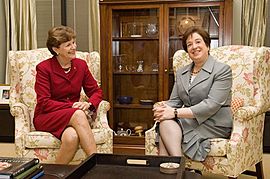
Kagan's confirmation hearings began on June 28, 2010. She showed a deep knowledge of Supreme Court cases. Like other nominees, she did not say how she would vote on specific issues. Some senators criticized this. Republican senators also noted her political background. Kagan promised to be fair and impartial.
On July 20, 2010, the Senate Judiciary Committee voted to recommend her confirmation. On August 5, the full Senate confirmed her nomination by a vote of 63 to 37. Most votes were along party lines.
Kagan's swearing-in ceremony was on August 7, 2010, at the White House. Chief Justice John Roberts gave her the oaths of office. She became the 112th justice of the Supreme Court. She was the first person appointed to the Court without any prior experience as a judge since 1972. She is the fourth female justice and the eighth Jewish justice in the Court's history.
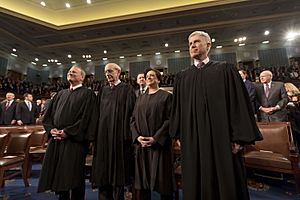
Legal Approach
Kagan is generally seen as a centrist justice. This means her views are often in the middle, not extremely liberal or conservative. When she was nominated, White House officials called her a "pragmatic progressive." This means she is progressive but also practical.
On the Court, she often tried to build agreement among the justices. However, after some major legal decisions that changed the Court's direction, she became more openly critical of the Court's shift. She often votes with the more liberal justices. For example, she voted to uphold ObamaCare's subsidies and to allow same-sex marriage nationwide.
Kagan was the justice responsible for handling emergency requests for certain federal appeals courts. After Justice Brett Kavanaugh joined the Court, she was assigned to the Ninth Circuit. This is the largest circuit court by area. It covers many states and territories in the western U.S.
Other Activities and Personal Life
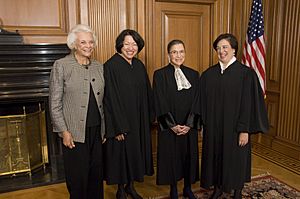
Like other justices, Kagan makes public appearances when she is not hearing cases. She often chooses to speak to students.
Time magazine named Kagan one of its 100 most influential people in 2013. Former Justice Sandra Day O'Connor wrote about Kagan, calling her "an incisive legal thinker" and "excellent communicator." In the same year, a painting of the four women who have served as Supreme Court justices was shown at the National Portrait Gallery.
Kagan has never married. Her friends describe her as a good conversationalist with a good sense of humor. Before joining the Supreme Court, she was known to play poker.
Early in her time as a justice, Kagan became friends with her new colleagues. She went to the opera with Ruth Bader Ginsburg. She had dinner with Sonia Sotomayor. She also went hunting with Antonin Scalia. This started because she promised a senator she would go hunting with Scalia if confirmed. Kagan is known to spend time with her longtime friends from law school and her time in the Clinton administration.
Images for kids
See also
 In Spanish: Elena Kagan para niños
In Spanish: Elena Kagan para niños



